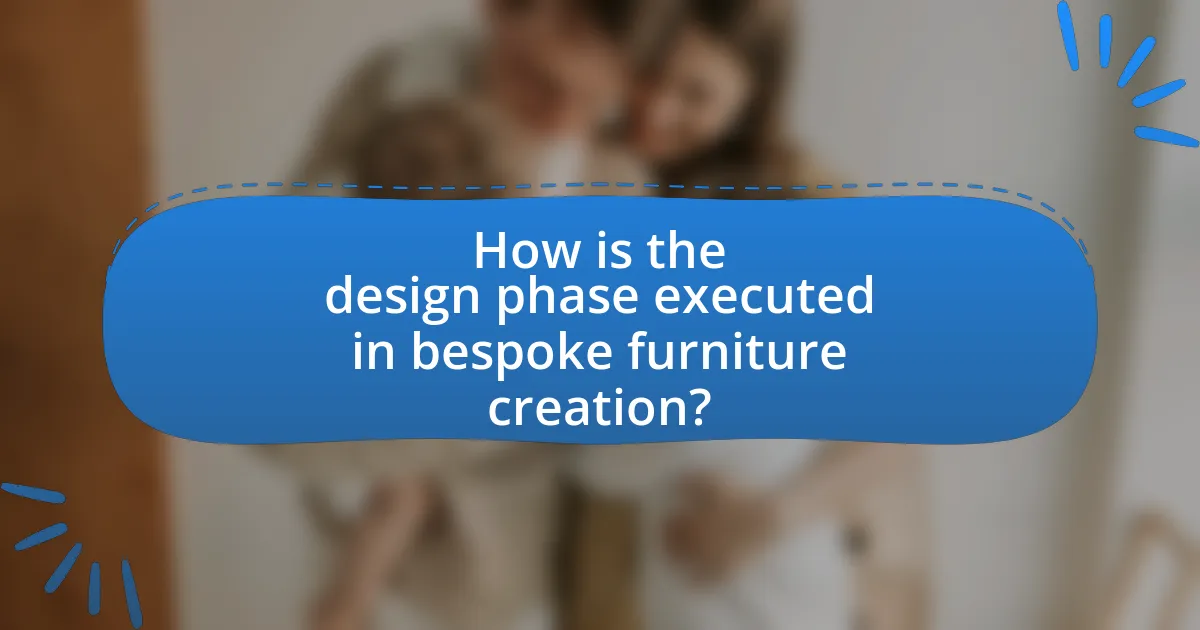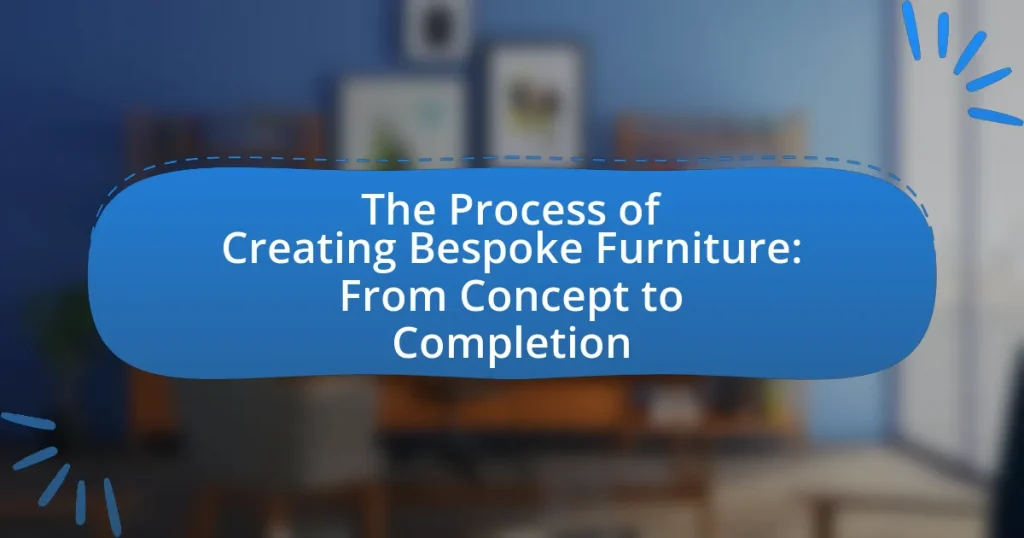The article focuses on the comprehensive process of creating bespoke furniture, detailing each stage from initial consultation to final delivery. It outlines key steps including design conceptualization, material selection, skilled crafting, and finishing techniques, emphasizing the importance of client collaboration and feedback throughout the process. Additionally, it addresses challenges such as design complexity and time management, while highlighting best practices for ensuring high-quality outcomes. The structured approach ensures that bespoke furniture meets individual client specifications and maintains high standards of craftsmanship.

What is the process of creating bespoke furniture?
The process of creating bespoke furniture involves several key steps: consultation, design, material selection, crafting, finishing, and delivery. Initially, a consultation takes place between the client and the designer to understand the client’s needs, preferences, and space requirements. Following this, a design phase occurs where sketches or digital models are created to visualize the final product.
Next, the selection of materials is crucial, as it impacts both aesthetics and durability; high-quality woods, fabrics, and finishes are typically chosen based on the design specifications. The crafting phase involves skilled artisans who construct the furniture, ensuring precision and attention to detail. After crafting, the finishing process enhances the furniture’s appearance and protects it, often involving sanding, staining, or varnishing. Finally, the completed piece is delivered to the client, ensuring it fits perfectly in the intended space. This structured approach ensures that bespoke furniture meets the unique requirements of each client while maintaining high standards of craftsmanship.
How does the bespoke furniture creation process begin?
The bespoke furniture creation process begins with an initial consultation between the client and the designer. During this meeting, the designer gathers information about the client’s needs, preferences, and the intended use of the furniture. This step is crucial as it establishes the foundation for the design, ensuring that the final product aligns with the client’s vision and requirements.
What initial considerations are important in bespoke furniture design?
Initial considerations in bespoke furniture design include understanding the client’s needs, assessing the space, selecting materials, and defining the budget. Understanding the client’s needs ensures that the design aligns with their preferences and lifestyle. Assessing the space involves measuring dimensions and evaluating existing decor to create a harmonious piece. Selecting materials is crucial for durability and aesthetics, as different materials can significantly impact the final product’s look and feel. Finally, defining the budget sets realistic expectations for the project scope and material choices, ensuring that the design remains feasible.
How do client preferences influence the design process?
Client preferences significantly influence the design process by guiding the aesthetic, functional, and material choices made by designers. These preferences shape the overall vision of the project, ensuring that the final product aligns with the client’s expectations and lifestyle needs. For instance, a study by the Design Council in 2020 highlighted that 75% of successful design projects directly incorporated client feedback during the initial stages, leading to higher satisfaction rates. This demonstrates that understanding and integrating client preferences not only enhances the design’s relevance but also fosters a collaborative relationship between the designer and the client, ultimately resulting in bespoke furniture that meets specific desires and requirements.
What are the key stages in the bespoke furniture creation process?
The key stages in the bespoke furniture creation process include consultation, design, material selection, crafting, finishing, and delivery. During the consultation stage, clients discuss their needs and preferences with the designer, establishing a clear vision for the piece. The design stage involves creating detailed sketches or 3D models to visualize the final product. Material selection follows, where appropriate woods, fabrics, and finishes are chosen based on durability and aesthetics. Crafting is the stage where skilled artisans build the furniture, ensuring precision and quality. The finishing stage involves applying stains, paints, or protective coatings to enhance appearance and longevity. Finally, delivery ensures the bespoke piece is transported and installed in the client’s space, completing the process. Each stage is crucial for achieving a high-quality, custom-made furniture piece that meets the client’s specifications.
What role does conceptualization play in bespoke furniture creation?
Conceptualization is crucial in bespoke furniture creation as it establishes the foundational vision and design intent for the piece. This initial phase involves understanding the client’s needs, preferences, and the intended functionality of the furniture, which guides the entire design process. For instance, a well-defined concept allows artisans to select appropriate materials, shapes, and finishes that align with the client’s aesthetic and practical requirements. Furthermore, effective conceptualization can lead to innovative designs that enhance both form and function, ultimately resulting in a unique piece that reflects the client’s personality and lifestyle.
How is material selection approached in bespoke furniture design?
Material selection in bespoke furniture design is approached through a careful evaluation of functionality, aesthetics, and sustainability. Designers assess the intended use of the furniture, ensuring that materials provide the necessary durability and comfort. Aesthetic considerations involve matching materials to the desired style and visual appeal of the piece, while sustainability focuses on sourcing eco-friendly options that minimize environmental impact. For instance, hardwoods like oak and walnut are often chosen for their strength and beauty, while reclaimed materials are increasingly popular for their environmental benefits. This multifaceted approach ensures that the final product meets both the practical needs and design vision of the client.
What challenges are faced during the bespoke furniture creation process?
The bespoke furniture creation process faces several challenges, including design complexity, material sourcing, and time management. Design complexity arises from the need to meet specific client requirements while ensuring functionality and aesthetics. Material sourcing can be difficult due to the need for high-quality, often rare materials that align with the design vision. Time management is critical, as delays in any phase of production can impact the overall timeline, leading to client dissatisfaction. These challenges necessitate skilled craftsmanship and effective communication between designers and clients to ensure successful project completion.
How do time constraints impact the creation of bespoke furniture?
Time constraints significantly impact the creation of bespoke furniture by limiting the time available for design, craftsmanship, and quality control. When time is restricted, designers may prioritize speed over detail, leading to compromises in the uniqueness and functionality of the furniture. Additionally, skilled artisans may face pressure to complete projects quickly, which can result in a decrease in craftsmanship quality and an increase in the likelihood of errors. Research indicates that projects with tight deadlines often experience a 20-30% reduction in overall quality due to rushed processes, as noted in studies on project management in the furniture industry.
What common design challenges arise in bespoke furniture projects?
Common design challenges in bespoke furniture projects include achieving precise measurements, ensuring material compatibility, and balancing aesthetics with functionality. Precise measurements are crucial as custom pieces must fit specific spaces, and inaccuracies can lead to costly adjustments. Material compatibility is essential because different materials may react differently to environmental factors, affecting durability and appearance. Additionally, designers often struggle to balance aesthetics with functionality, as a visually appealing design may compromise usability or comfort. These challenges are frequently encountered in the bespoke furniture industry, highlighting the complexity of creating tailored pieces that meet client expectations while maintaining structural integrity and usability.

How is the design phase executed in bespoke furniture creation?
The design phase in bespoke furniture creation is executed through a collaborative process involving client consultations, concept sketches, and detailed design specifications. Initially, designers engage with clients to understand their needs, preferences, and space requirements, which informs the overall vision for the piece. Following this, designers create concept sketches that visualize the ideas discussed, allowing for client feedback and adjustments. Once the concept is approved, detailed design specifications, including materials, dimensions, and finishes, are developed to guide the crafting process. This structured approach ensures that the final product aligns with the client’s expectations and functional requirements.
What techniques are used to develop design concepts?
Techniques used to develop design concepts include brainstorming, sketching, prototyping, and user feedback. Brainstorming allows designers to generate a wide range of ideas quickly, while sketching helps visualize these ideas in a tangible form. Prototyping enables the creation of physical or digital models to test functionality and aesthetics. User feedback is essential for refining concepts based on real-world usability and preferences. These techniques are widely recognized in design methodologies, such as the Design Thinking framework, which emphasizes iterative development and user-centered design.
How do sketches and digital models aid in the design process?
Sketches and digital models significantly aid in the design process by providing visual representations that facilitate communication and refinement of ideas. Sketches allow designers to quickly explore concepts, enabling rapid iteration and feedback, while digital models offer detailed, scalable, and manipulable representations that can simulate real-world conditions. Research indicates that visual tools enhance creativity and problem-solving, as evidenced by a study published in the Journal of Design Research, which found that designers using sketches and digital models reported higher satisfaction and effectiveness in their design outcomes.
What feedback mechanisms are in place during the design phase?
During the design phase of creating bespoke furniture, feedback mechanisms include client consultations, design reviews, and prototype evaluations. Client consultations allow for direct input on preferences and requirements, ensuring alignment with the client’s vision. Design reviews involve collaborative sessions with stakeholders to assess design concepts and make necessary adjustments. Prototype evaluations provide tangible models for clients to interact with, facilitating real-time feedback on functionality and aesthetics. These mechanisms ensure that the final product meets client expectations and design standards.
How is client collaboration facilitated during the design phase?
Client collaboration during the design phase is facilitated through regular communication and feedback sessions. Designers engage clients by conducting meetings, utilizing visual aids like sketches and 3D models, and incorporating client input into the design iterations. This approach ensures that the client’s vision is accurately captured and refined, leading to a final product that aligns with their expectations. Studies show that projects with frequent client interactions have a 30% higher satisfaction rate, highlighting the effectiveness of this collaborative method.
What methods are used to gather client input effectively?
Effective methods to gather client input include surveys, interviews, focus groups, and feedback forms. Surveys allow for quantitative data collection, enabling designers to analyze preferences and trends. Interviews provide qualitative insights, allowing for deeper understanding of client needs and desires. Focus groups facilitate discussion among multiple clients, generating diverse perspectives and ideas. Feedback forms capture client opinions post-project, helping to refine future processes. These methods are validated by their widespread use in design and customer service industries, demonstrating their effectiveness in understanding client requirements.
How is client feedback integrated into the design revisions?
Client feedback is integrated into design revisions through structured review sessions and iterative design processes. During these sessions, designers present initial concepts and prototypes to clients, allowing for direct input on aesthetics, functionality, and materials. This feedback is then systematically analyzed and incorporated into subsequent design iterations, ensuring that the final product aligns with the client’s vision and requirements. Research indicates that involving clients in the design process enhances satisfaction and leads to better alignment with their expectations, as seen in studies on collaborative design methodologies.

What are the final steps in completing bespoke furniture?
The final steps in completing bespoke furniture include finishing, assembly, and quality inspection. Finishing involves applying stains, paints, or protective coatings to enhance aesthetics and durability. Assembly requires putting together the various components, ensuring that all joints are secure and functional. Finally, quality inspection checks for any defects or inconsistencies, ensuring that the piece meets the specified design and craftsmanship standards. These steps are crucial for delivering a high-quality, custom-made product that satisfies client expectations.
How is the production phase managed in bespoke furniture creation?
The production phase in bespoke furniture creation is managed through a structured process that includes detailed planning, skilled craftsmanship, and quality control. Initially, designers collaborate with clients to finalize specifications, ensuring that materials and designs align with customer preferences. Following this, skilled artisans utilize traditional and modern techniques to construct the furniture, often employing tools like CNC machines for precision. Quality control measures are implemented throughout the production to ensure that each piece meets the established standards, with inspections at various stages of the process. This systematic approach ensures that the final product not only meets the client’s expectations but also adheres to industry standards for durability and aesthetics.
What tools and techniques are essential for crafting bespoke furniture?
Essential tools for crafting bespoke furniture include a table saw, miter saw, router, chisels, and hand planes, while techniques involve joinery, sanding, finishing, and upholstery. The table saw allows for precise cuts, the miter saw is crucial for angled cuts, and the router is used for shaping edges. Joinery techniques, such as dovetail and mortise-and-tenon joints, ensure strong connections, while sanding and finishing techniques enhance the aesthetic and durability of the furniture. Upholstery techniques are vital for adding comfort and style to pieces. These tools and techniques are foundational in the bespoke furniture-making process, ensuring quality and craftsmanship.
How is quality control maintained throughout the production process?
Quality control is maintained throughout the production process by implementing systematic inspections and standardized procedures at each stage of manufacturing. These inspections include initial material assessments, in-process checks, and final product evaluations to ensure compliance with design specifications and quality standards. For instance, using tools like calipers and gauges during production allows for precise measurements, while adherence to industry standards, such as ISO 9001, provides a framework for consistent quality management. Additionally, feedback loops from quality assessments inform continuous improvement practices, ensuring that any defects are addressed promptly and do not recur in future production runs.
What is involved in the finishing touches of bespoke furniture?
The finishing touches of bespoke furniture involve applying final coatings, ensuring precise detailing, and conducting quality checks. These steps enhance the aesthetic appeal and durability of the piece. Final coatings typically include varnishes, stains, or oils that protect the wood and enhance its natural beauty. Precise detailing may involve sanding edges, polishing surfaces, and ensuring that all joints are seamless. Quality checks ensure that the furniture meets the client’s specifications and industry standards, confirming that it is both functional and visually appealing.
How do finishing techniques enhance the final product?
Finishing techniques enhance the final product by improving aesthetics, durability, and functionality. These techniques, such as sanding, staining, and sealing, create a smooth surface, enhance the wood grain, and protect against moisture and wear. For instance, a study by the Forest Products Laboratory indicates that proper finishing can increase the lifespan of wooden furniture by up to 50%, demonstrating the significant impact of these techniques on both appearance and longevity.
What role does client approval play in the completion of bespoke furniture?
Client approval is essential in the completion of bespoke furniture as it ensures that the final product aligns with the client’s vision and specifications. This approval process typically involves reviewing design proposals, materials, and finishes, which allows clients to provide feedback and make necessary adjustments before production begins. According to industry standards, obtaining client approval minimizes the risk of dissatisfaction and costly revisions, thereby streamlining the overall production timeline and enhancing the quality of the final piece.
What best practices should be followed in bespoke furniture creation?
Best practices in bespoke furniture creation include thorough client consultation, precise measurements, quality material selection, skilled craftsmanship, and attention to detail. Engaging in detailed discussions with clients ensures that their specific needs and preferences are understood, which is crucial for creating personalized pieces. Accurate measurements are essential to ensure that the furniture fits perfectly in the intended space, preventing costly mistakes. Choosing high-quality materials enhances durability and aesthetics, as evidenced by studies showing that premium materials can significantly increase the lifespan of furniture. Skilled craftsmanship is vital, as it directly impacts the functionality and visual appeal of the final product. Lastly, meticulous attention to detail during the design and finishing processes ensures that the furniture meets the highest standards of quality and design integrity.
How can effective communication improve the bespoke furniture process?
Effective communication enhances the bespoke furniture process by ensuring that client specifications and preferences are accurately understood and implemented. Clear dialogue between clients and craftsmen facilitates the exchange of ideas, leading to a more tailored design that meets the client’s vision. For instance, when clients articulate their needs and preferences effectively, it reduces the likelihood of misunderstandings, which can lead to costly revisions or dissatisfaction with the final product. Additionally, regular updates and feedback during the production phase allow for adjustments to be made promptly, ensuring that the final piece aligns closely with the initial concept. This approach not only improves client satisfaction but also streamlines the workflow, ultimately resulting in a more efficient production process.
What tips can ensure a successful bespoke furniture project from start to finish?
To ensure a successful bespoke furniture project from start to finish, clear communication with the designer is essential. This involves discussing specific requirements, preferences, and budget constraints upfront, which helps in aligning expectations and avoiding misunderstandings. Additionally, thorough planning, including detailed sketches and material selections, is crucial as it provides a roadmap for the project. Researching and selecting a reputable craftsman or manufacturer with a proven track record in bespoke furniture is also vital, as their expertise directly impacts the quality of the final product. Regular updates and feedback during the production process can help address any issues promptly, ensuring the project stays on track and meets the desired specifications.


